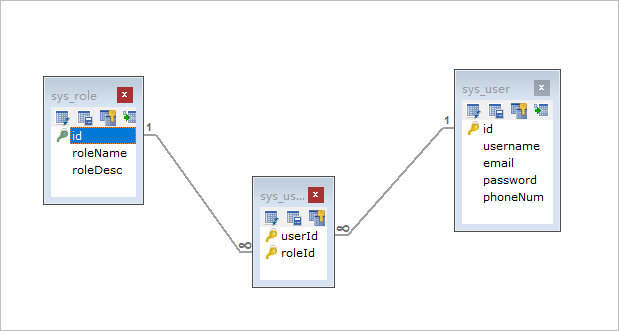Spring练习
01-Spring练习-环境搭建步骤分析(理解)
案例环境搭建步骤:
①创建工程(Project&Module)
②导入静态页面(见资料jsp页面)
③导入需要坐标(见资料中的pom.xml)
④创建包结构(controller、service、dao、domain、utils)
⑤导入数据库脚本(见资料test.sql)
⑥创建POJO类(见资料User.java和Role.java)
创建配置文件(applicationContext.xml,spring-mvc.xml,jdbc.properties,log4j.properties)
02-Spring练习-环境搭建实现1(应用)
创建工程,导入jsp,添加项目依赖
创建包结构,导入数据库脚本,导入POJO
03-Spring练习-环境搭建实现2(应用)
创建Spring的核心配置文件applicationContext.xml
创建SpringMVC核心配置文件spring-mvc.xml
创建数据库配置文件jdbc.properties
拷贝日志配置文件log4j.properties
配置web.xml如下:
<!--全局的初始化参数-->
<context-param>
<param-name>contextConfigLocation</param-name>
<param-value>classpath:applicationContext.xml</param-value>
</context-param>
<!--Spring的监听器-->
<listener>
<listener-class>org.springframework.web.context.ContextLoaderListener</listener-class>
</listener>
<!--SpringMVC的前端控制器-->
<servlet>
<servlet-name>DispatcherServlet</servlet-name>
<servlet-class>org.springframework.web.servlet.DispatcherServlet</servlet-class>
<init-param>
<param-name>contextConfigLocation</param-name>
<param-value>classpath:spring-mvc.xml</param-value>
</init-param>
<load-on-startup>2</load-on-startup>
</servlet>
<servlet-mapping>
<servlet-name>DispatcherServlet</servlet-name>
<url-pattern>/</url-pattern>
</servlet-mapping>
04-Spring练习-环境搭建实现3(应用)
配置springm-mvc.xml:注解驱动,视图解析器,静态资源的开放
配置如下:
<!--1、mvc注解驱动-->
<mvc:annotation-driven/>
<!--2、配置视图解析器-->
<bean class="org.springframework.web.servlet.view.InternalResourceViewResolver">
<property name="prefix" value="/pages/"/>
<property name="suffix" value=".jsp"/>
</bean>
<!--3、静态资源权限开放-->
<mvc:default-servlet-handler/>
05-Spring练习-环境搭建实现4(应用)
配置applicationContext.xml:加载propertiest,配置数据源对象,配置JdbcTemplate对象
配置如下:
<?xml version="1.0" encoding="UTF-8"?>
<beans xmlns="http://www.springframework.org/schema/beans"
xmlns:xsi="http://www.w3.org/2001/XMLSchema-instance"
xmlns:context="http://www.springframework.org/schema/context"
xsi:schemaLocation="
http://www.springframework.org/schema/beans http://www.springframework.org/schema/beans/spring-beans.xsd
http://www.springframework.org/schema/context http://www.springframework.org/schema/context/spring-context.xsd
">
<!--1、加载jdbc.properties-->
<context:property-placeholder location="classpath:jdbc.properties"/>
<!--2、配置数据源对象-->
<bean id="dataSource" class="com.mchange.v2.c3p0.ComboPooledDataSource">
<property name="driverClass" value="${jdbc.driver}"/>
<property name="jdbcUrl" value="${jdbc.url}"/>
<property name="user" value="${jdbc.username}"/>
<property name="password" value="${jdbc.password}"/>
</bean>
<!--3、配置JdbcTemplate对象-->
<bean id="jdbcTemplate" class="org.springframework.jdbc.core.JdbcTemplate">
<property name="dataSource" ref="dataSource"></property>
</bean>
</beans>
06-Spring练习-用户表和角色表的分析(理解)
分析用户和角色在数据库设计中的表关系:多对多关系,关系如图所示:

07-Spring练习-角色列表展示分析(理解)
需求:角色列表展示,需求如图所示:

完成该功能的思路和步骤为:
①点击角色管理菜单发送请求到服务器端(修改角色管理菜单的url地址)
②创建RoleController和list()方法
③创建RoleService和list()方法
④创建RoleDao和findAll()方法
⑤使用JdbcTemplate完成查询操作
⑥将查询数据存储到modelAndView中
⑦转发到role-list.jsp页面进行展示
08-Spring练习-角色列表展示-controller层实现(应用)
1:修改左侧菜单链接地址
<ul class="treeview-menu">
<li><a
href="${pageContext.request.contextPath}/user/list"> <i
class="fa fa-circle-o"></i> 用户管理
</a></li>
<li><a
href="${pageContext.request.contextPath}/role/list"> <i
class="fa fa-circle-o"></i> 角色管理
</a></li>
<li><a
href="${pageContext.request.contextPath}/pages/syslog-list.jsp"> <i
class="fa fa-circle-o"></i> 访问日志
</a></li>
</ul>
Controller层代码:
@RequestMapping("/role")
@Controller
public class RoleController {
@Autowired
private RoleService roleService;
@RequestMapping("/list")
public ModelAndView list(){
ModelAndView modelAndView = new ModelAndView();
List<Role> roleList = roleService.list();
//设置模型
modelAndView.addObject("roleList",roleList);
//设置视图
modelAndView.setViewName("role-list");
System.out.println(roleList);
return modelAndView;
}
}
09-Spring练习-角色列表展示-service和dao层实现(应用)
service层代码:
public class RoleServiceImpl implements RoleService {
private RoleDao roleDao;
public void setRoleDao(RoleDao roleDao) {
this.roleDao = roleDao;
}
public List<Role> list() {
List<Role> roleList = roleDao.findAll();
return roleList;
}
}
dao层代码:
public class RoleDaoImpl implements RoleDao {
private JdbcTemplate jdbcTemplate;
public void setJdbcTemplate(JdbcTemplate jdbcTemplate) {
this.jdbcTemplate = jdbcTemplate;
}
public List<Role> findAll() {
List<Role> roleList = jdbcTemplate.query("select * from sys_role", new BeanPropertyRowMapper<Role>(Role.class));
return roleList;
}
}
10-Spring练习-角色列表展示-配置实现(应用)
配置spring-mvc.xml
<!--4、组件扫描 扫描Controller-->
<context:component-scan base-package="com.itheima.controller"/>
配置applicationContext.xml
<!--配置RoleService-->
<bean id="roleService" class="com.itheima.service.impl.RoleServiceImpl">
<property name="roleDao" ref="roleDao"/>
</bean>
<!--配置RoleDao-->
<bean id="roleDao" class="com.itheima.dao.impl.RoleDaoImpl">
<property name="jdbcTemplate" ref="jdbcTemplate"/>
</bean>
11-Spring练习-角色列表展示-页面展示(应用)
在role-list.jsp中将数据取出来并展示,核心代码如下:
<c:forEach items="${roleList}" var="role">
<tr>
<td><input name="ids" type="checkbox"></td>
<td>${role.id}</td>
<td>${role.roleName}</td>
<td>${role.roleDesc}</td>
<td class="text-center">
<a href="javascript:void(0);" class="btn bg-olive btn-xs">删除</a>
</td>
</tr>
</c:forEach>
12-Spring练习-角色的添加操作(应用)
需求:添加角色,需求图如下:

操作步骤如下:
①点击列表页面新建按钮跳转到角色添加页面
②输入角色信息,点击保存按钮,表单数据提交服务器
③编写RoleController的save()方法
④编写RoleService的save()方法
⑤编写RoleDao的save()方法
⑥使用JdbcTemplate保存Role数据到sys_role
⑦跳转回角色列表页面
controller代码如下:
@RequestMapping("/save")
public String save(Role role){
roleService.save(role);
return "redirect:/role/list";
}
service代码如下:
public void save(Role role) {
roleDao.save(role);
}
dao代码如下:
public void save(Role role) {
jdbcTemplate.update("insert into sys_role values(?,?,?)",null,role.getRoleName(),role.getRoleDesc());
}
为了解决post提交中文乱码问题,需要在web.xml中配置全局乱码过滤器
<!--解决乱码的过滤器-->
<filter>
<filter-name>CharacterEncodingFilter</filter-name>
<filter-class>org.springframework.web.filter.CharacterEncodingFilter</filter-class>
<init-param>
<param-name>encoding</param-name>
<param-value>UTF-8</param-value>
</init-param>
</filter>
<filter-mapping>
<filter-name>CharacterEncodingFilter</filter-name>
<url-pattern>/*</url-pattern>
</filter-mapping>
测试,完成该功能。
13-Spring练习-用户列表展示1(应用)
需求:查询用户列表,需求图如下:

完成该功能的操作步骤:
①点击用户管理菜单发送请求到服务器端(修改用户管理菜单的url地址)
②创建UserController和list()方法
③创建UserService和list()方法
④创建UserDao和findAll()方法
⑤使用JdbcTemplate完成查询操作
⑥将查询数据存储到modelAndView中
⑦转发到user-list.jsp页面进行展示
跟查询角色列表一样,查询用户列表,创建UserController,UserService,UserDao,User实体等结构,编写各层代码并配置
用户列表Controller,service,dao层代码如下:
controller
@RequestMapping("/list")
public ModelAndView list(){
List<User> userList = userService.list();
ModelAndView modelAndView = new ModelAndView();
modelAndView.addObject("userList",userList);
modelAndView.setViewName("user-list");
return modelAndView;
}
service:
public List<User> list() {
List<User> userList = userDao.findAll();
//封装userList中的每一个User的roles数据
return userList;
}
dao:
public List<User> findAll() {
List<User> userList = jdbcTemplate.query("select * from sys_user", new BeanPropertyRowMapper<User>(User.class));
return userList;
}
14-Spring练习-用户列表展示2(应用)
查询用户的时候关联查询出该用户所具有的所有角色信息,需要完善查询用户的service层代码
1,在角色的dao中添加方法,根据用户id查询角色列表
//在角色dao中根据用户id查询用户具有的角色信息
public List<Role> findRoleByUserId(Long id) {
List<Role> roles = jdbcTemplate.query("select * from sys_user_role ur,sys_role r where ur.roleId=r.id and ur.userId=?", new BeanPropertyRowMapper<Role>(Role.class), id);
return roles;
}
完善userservcie层代码如下:
//在查询用户的service中关联查询用户具有的角色
public List<User> list() {
List<User> userList = userDao.findAll();
//封装userList中的每一个User的roles数据
for (User user : userList) {
//获得user的id
Long id = user.getId();
//将id作为参数 查询当前userId对应的Role集合数据
List<Role> roles = roleDao.findRoleByUserId(id);
user.setRoles(roles);
}
return userList;
}
查询用户的时候关联查询出该用户所具有的所有角色信息,前端jsp页面核心代码
<c:forEach items="${userList}" var="user">
<tr>
<td><input name="ids" type="checkbox"></td>
<td>${user.id}</td>
<td>${user.username}</td>
<td>${user.email}</td>
<td>${user.phoneNum}</td>
<td class="text-center">
<c:forEach items="${user.roles}" var="role">
${role.roleName}
</c:forEach>
</td>
<td class="text-center">
<a href="javascript:void(0);" onclick="delUser('${user.id}')" class="btn bg-olive btn-xs">删除</a>
</td>
</tr>
</c:forEach>
15-Spring练习-用户添加操作-添加页面展示(应用)
需求:添加用户,需求图如下:

新建用户时,点击新建按钮先去到添加用户的页面user-add.jsp,在添加用户页面需要展示可供选择的角色信息,因此来到添加页面时需要查询所有的角色信息并展示
去到user-add.jsp页面时先查询所有角色信息的controller代码
@RequestMapping("/saveUI")
public ModelAndView saveUI(){
ModelAndView modelAndView = new ModelAndView();
List<Role> roleList = roleService.list();
modelAndView.addObject("roleList",roleList);
modelAndView.setViewName("user-add");
return modelAndView;
}
因为查询所有角色信息的service层和dao层代码在之前角色列表展示功能的时候已经写了,因此只需调用即可,
在user-add.jsp页面展示所有角色信息的核心代码
<div class="col-md-10 data">
<c:forEach items="${roleList}" var="role">
<input class="" type="checkbox" name="roleIds" value="${role.id}">${role.roleName}
</c:forEach>
</div>
16-Spring练习-用户添加操作-添加数据到数据库(应用)
添加用户页面有两部分数据,一部分属于用户基础数据需要插入到用户表user中,另一部分是用户的角色数据,需要插入到中间表sys_user_role中
user-add.jsp页面提交数据到controller完成数据添加操作的controller层和service层代码分别如下:
//controller层代码
@RequestMapping("/save")
public String save(User user,Long[] roleIds){
userService.save(user,roleIds);
return "redirect:/user/list";
}
//service层代码
public void save(User user, Long[] roleIds) {
//第一步 向sys_user表中存储数据
Long userId = userDao.save(user);
//第二步 向sys_user_role 关系表中存储多条数据
userDao.saveUserRoleRel(userId,roleIds);
}
dao层代码因为还需要重新构建,因此学完下一个章节后重新编写,因为这里留下了一个问题,在dao层操作后如何获得自增的主键id值呢?
17-Spring练习-用户添加操作-添加数据到数据库2(应用)
添加用户时用户分配的角色信息应存储到中间表sys_user_role表中,需要用户的id,角色的id,而角色的id由前台页面点选的,用户的id应该是在保存操作由mysql主键自动生成的,那如何获取mysql自增的主键值呢?
使用JdbcTemplate执行插入操作时获取mysql自增的主键值:
添加操作的dao层代码如下:
public void saveUserRoleRel(Long userId, Long[] roleIds) {
for (Long roleId : roleIds) {
jdbcTemplate.update("insert into sys_user_role values(?,?)",userId,roleId);
}
}
18-Spring练习-删除用户操作(应用)
删除用户功能的需求如图所示:

操作步骤如下:
①点击用户列表的删除按钮,发送请求到服务器端
②编写UserController的del()方法
③编写UserService的del()方法
⑤编写UserDao的delUserRoleRel()方法
⑥跳回当前用户列表页面
完成用户的删除操作,不仅要删除用户表数据,同时需要将用户和角色的关联表数据进行删除:
controller代码
@RequestMapping("/del/{userId}")
public String del(@PathVariable("userId") Long userId){
userService.del(userId);
return "redirect:/user/list";
}
service代码
public void del(Long userId) {
//1、删除sys_user_role关系表
userDao.delUserRoleRel(userId);
//2、删除sys_user表
userDao.del(userId);
}
dao代码:不仅要删除用户表数据,同时需要将用户和角色的关联表数据进行删除
public void delUserRoleRel(Long userId) {
jdbcTemplate.update("delete from sys_user_role where userId=?",userId);
}
public void del(Long userId) {
jdbcTemplate.update("delete from sys_user where id=?",userId);
}